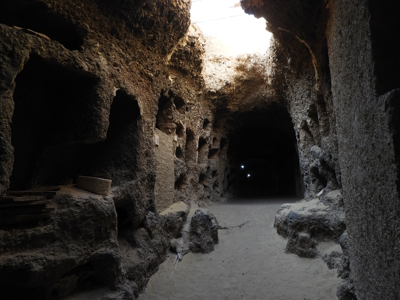Necropolises of Middle Egypt

Necropolises of Middle Egypt, from the Middle Empire to the Roman period is part of the Tentative list of Egypt in order to qualify for inclusion in the World Heritage List.
The Necropolises of Middle Egypt comprise 4 necropolises, dating from the 3rd century BC til the 1st century AD. They include Royal tombs which often were decorated and painted in classical Egyptian, Amarna and Greek style.
Map of Necropolises of Middle Egypt
Load mapThe coordinates shown for all tentative sites were produced as a community effort. They are not official and may change on inscription.
Community Reviews
Nan

To get a firm grasp of Egyptian history is something that has evaded me for decades. The time spans (millennia?!) involved are just too large. Ancient Egypt starts around 3000 BCE and lasts roughly till the Romans take over around 30 BCE. In such a long timespan, you are bound to get lost with all the pharaohs, dynasties and factions.
There are only a few pharaohs I remember by heart: Hatshepsut, Ramses and Akhenaten (Echnaton in German). The later one I found the most intriguing from the start: a pharaoh undoing polytheistic traditions and practicing monotheism. Wow. Online (and disproven) legends have him exalted as the father of Judaism.
Indeed, the monotheism part is also a bit overblown. On the History of Egypt podcast, they thoroughly went through this. It seems more likely that Aten was the highest and the superior god in the Egyptian pantheon, but that lower gods were still accepted. Only god that Akhenaten seems to have explicitly banned is Amun with his powerful priesthood in Thebes.
With Thebes so tightly linked with the despised old god, Akhenaten couldn't keep his capital at Thebes/Luxor, in Amun land. Instead, he built a complete new capital down river, named Akhetaten, present day Amarna. Closest major town is Mallawi.
The dimensions of Akhetaten are mind boggling. You get a good grasp of the site standing at the Great Aten Temple overlooking the plains till the mountain ranges. That doesn't even include the Royal Tomb of Akhenaten hidden well in the mountains.
When Akhetaten passed away, both his new religion and his new capital were quickly abandoned. Subsequent pharaohs made an effort to eliminate his memory and destroying associated monuments all across Egypt.
The tangible highlights of the visit are the tombs. These are tombs of citizens, not nobles. My guide gave a good introduction to each and it was very insightful. In addition, you will be on your own.
OUV
According to my guide, Unesco has been nudging the Egyptians for a long time to finally add Amarna to the list. The dimension of the site, the cultural significance ... This is a sure inscription if the Egyptians ever get around to it.
Why this hasn't been inscribed yet, your guess is as good as mine. Only explanation I could come up with is how Egypt manages their tourism. Essentially, tourists are restricted to certain parts of the country (Cairo, Aswan/Luxor, Red Sea coast). Outside the tourist zones travel becomes difficult due to special security. My guess is that Amarna being outside the core tourist zones, they don't want to advertise it.
I can't judge (as I haven't visited) the other components. Personally, I think it's wrong to combine Amarna with any other site. This should be a site on its own to express its historical significance.
Getting There
This one is tricky. The region between Luxor and Cairo is not really accessible for individual tourists. Easiest option is to join a tour across Egypt. Amarna can be used as stopping point when travelling between Cairo and Abydos (very long day).
If you plan to do it by yourself, the best train station is Mallawī for all three sites. The town has hotels, but you can't book/find them online. It seems you have to contact them via facebook. The closest hotel on booking is in al-Minya. Given the scale of the site, staying a night, probably makes sense.
In any case, I do recommend arranging a guide and driver upfront to wait for you at the train station. I do have a contact, so ping me. Or ask your hotel to help out. If you arrive without a driver and guide prearranged (like I did), expect to be spend some time with the police. You can't move freely in this part of Egypt. After an hour (?) they had a arranged a driver and a security guard who took me to the site. The site itself is huge, so you need a car anyhow.
I left in the afternoon by train to Bani Suwaif where the police arranged another cab for me to take me to Tunis for the Valley of Whales.
Getting Around
The dimension of Amarna are a bit hard to grasp. The Royal Tomb of Akhenaten is ~10km into the desert. The remains of his city stretch to the horizon. To visit properly, you likely need a day. And I am not even counting the other two sites included in the nomination. You will need a driver. You can get a good overview with help of the site maps on wikipedia. I found the German wikipedia map better than the English one.
Last point: Bring cash in small bills. You will have to pay the security guards, the guide, ...
Site Info
Site History
2003 Added to Tentative List
Site Links
Locations
The site has 3 locations
Visitors
31 Community Members have visited.